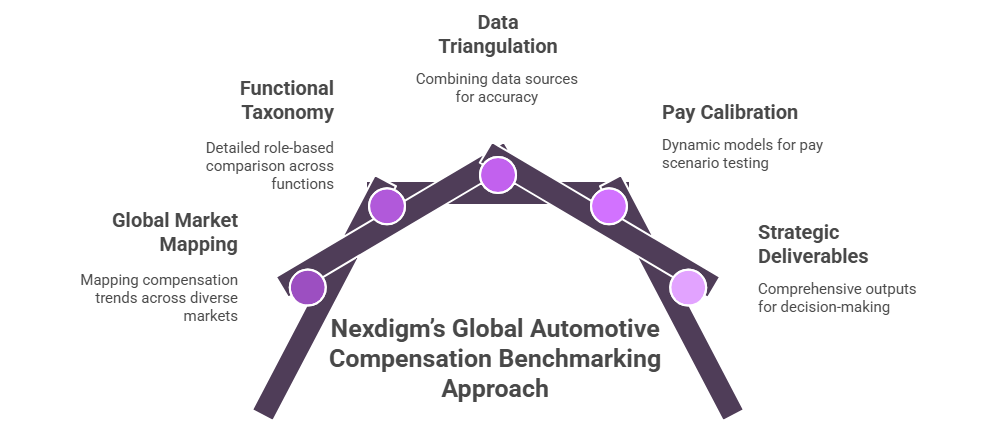As the global automotive industry accelerates toward electrification, software-defined vehicles, and autonomous mobility, the need for globally consistent and strategically aligned compensation frameworks has never been greater. OEMs and Tier-1 suppliers are operating across multiple geographies, each with its own labor dynamics, cost structures, and regulatory ecosystems. Yet, despite this globalization, compensation design often remains fragmented, reactive, and region-specific.
The shift from mechanical to digital engineering has expanded the war for talent beyond traditional boundaries. A software integration specialist in Munich, a battery engineer in Seoul, and a data scientist in Bengaluru may now contribute to the same global EV program, yet their compensation structures differ dramatically. Such disparities impact talent mobility, cost optimization, and organizational cohesion, often leading to internal inequities or unintentional market misalignment.
In this context, a Global Automotive Compensation Benchmarking Study emerges as more than an HR exercise. It enables organizations to align pay frameworks across regions, balance competitiveness with equity, and build a unified approach to global workforce management.
Why Global Compensation Benchmarking Matters
The global automotive sector is entering an era where human capital strategy defines competitive advantage as much as manufacturing efficiency or technological innovation. As OEMs and Tier-1 suppliers expand across diverse geographies, the challenge lies in maintaining pay equity, regional competitiveness, and financial control simultaneously. A Global Compensation Benchmarking Study bridges these gaps by turning compensation data into strategic foresight. Here’s how it creates tangible impact across organizational layers:
- Aligning Global Pay Structures With Strategic Objectives: Global benchmarking provides leadership teams with a unified view of salary and incentive structures across subsidiaries, R&D centers, and manufacturing units. This alignment ensures that pay scales reflect not only local market realities but also the global strategic intent.
- Enabling Talent Mobility and Cross-Border Collaboration: As automotive programs become globally distributed, high-value talent frequently transitions across markets. Benchmarking enables HR leaders to design mobility-ready compensation packages, balancing competitiveness in home and host countries.
- Achieving Cost Efficiency and Predictability: In global operations, inconsistent pay scales can distort budgeting and long-term workforce planning. A standardized benchmarking framework helps finance and HR teams forecast workforce expenditure with precision.
- Strengthening Employer Brand and Retention: Compensation transparency has become a key factor in attracting and retaining skilled automotive professionals. Global benchmarking helps organizations project a consistent, equitable, and credible pay philosophy, enhancing trust and employer reputation across regions. When employees perceive parity between global and local peers, engagement and retention naturally improve.
- Building Compliance and ESG Alignment: As ESG and pay equity reporting gain traction, global OEMs are expected to demonstrate responsible compensation governance. Benchmarking enables organizations to comply with regional labor transparency norms while showcasing equitable pay practices as part of their sustainability and diversity agendas.
Nexdigm’s Global Automotive Compensation Benchmarking Approach
At Nexdigm, we recognize that compensation benchmarking is about generating strategic intelligence that supports global workforce planning, financial control, and talent competitiveness. Our Global Automotive Compensation Benchmarking framework integrates multi-country analytics, market intelligence, and functional benchmarking to deliver evidence-based pay alignment strategies for OEMs and Tier-1 suppliers.

- Global Market Mapping and Industry Peer Analysis: We begin by mapping compensation trends across 30+ automotive and technology markets, covering OEMs, Tier-1 suppliers, and emerging EV disruptors. This benchmarking includes diverse cost geographies—from developed economies like Germany, Japan, and the U.S. to cost-efficient hubs such as India, Thailand, and Mexico. The objective is to help clients visualize global pay gradients, identify gaps, and realign pay structures across business units.
- Functional and Role-Based Taxonomy: Our benchmarking framework is anchored in a detailed role taxonomy, enabling comparison across engineering, R&D, production, digital mobility, and corporate functions. Each job family is further segmented by skill specialization to ensure skill-specific pay benchmarking. This approach helps organizations identify high-value technical roles where competitive compensation is essential to attract and retain talent.
- Data Triangulation and Validation: Nexdigm follows a rigorous data triangulation model combining: Publicly available disclosures, Industry and HR data sources, Proprietary Nexdigm intelligence databases and primary research inputs. The data is normalized for currency, taxation, benefit ratios, and cost-of-living variations, ensuring accurate cross-country comparability and compliance with global pay equity standards.
- Pay Calibration and Compensation Modeling: We build dynamic compensation models that integrate both fixed and variable pay components, factoring regional labor inflation and productivity metrics. These models help clients test multiple pay scenarios, evaluate total reward competitiveness, and simulate the financial impact of harmonizing pay across subsidiaries or new market expansions.
- Strategic Deliverables: Clients receive a comprehensive output suite, including Global Compensation Heatmaps for critical automotive functions, Regional Pay Parity and Differentiation Matrices, Variable Pay Benchmark Dashboards, Pay Equity & Compliance Insights aligned with global ESG disclosure norms. These deliverables empower HR, Finance, and Strategy leaders to make data-driven compensation decisions that balance global standardization with local adaptability.
Through its Global Automotive Compensation Benchmarking framework, Nexdigm bridges human capital intelligence with corporate strategy.
To take the next step, simply visit our Request a Consultation page and share your requirements with us.
Harsh Mittal
+91-8422857704

